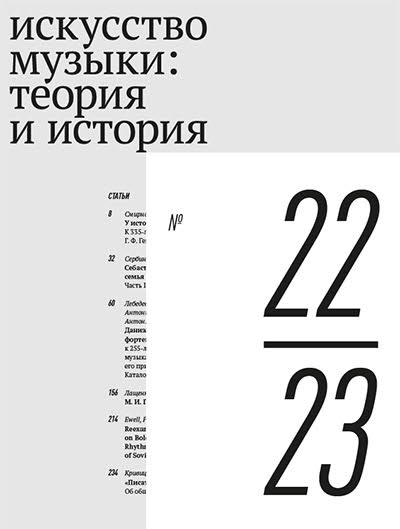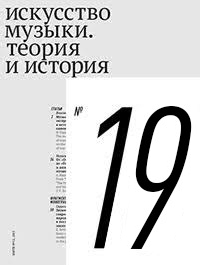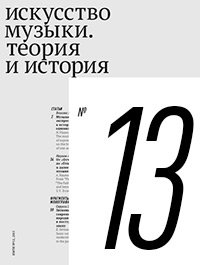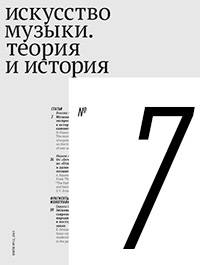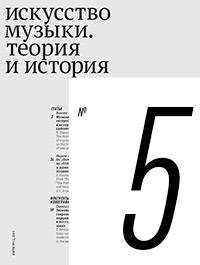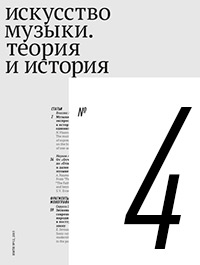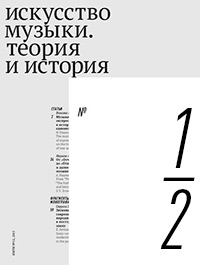2014 №№ 10-11
The doubled issue of the journal Art of Music. Theory and History (№№10–11, 2014) includes several rubrics: apart from major articles dealing with problems of Russian music and cultural history, it contains papers in English and in German on contemporary Russian music-educational practice, an excerpt from a large-scale scholarly project in progress, a pioneering publication of archival documents, and a presentation of recently published book.
The present article was written in the process of preparing for publication the full score of Borodin’s Second Symphony in the author’s version. In the 1930s this task was already accomplished by Pavel Lamm; his work, however, remained unpublished. Though subsequently the author’s version would attract the attention of some scholars and conductors, no publications on it appeared in Russian before 2008. According to the opinion that dominated in the official music historiography, the changes introduced by Nikolai Rimsky-Korsakov and Aleksandr Glazunov in the work’s posthumous edition were authorized by Borodin himself. The analysis of manuscript sources, as well as the study of the symphony’s compositional and early performance history, show that such an opinion is erroneous.
The article reconstructs some circumstances of the Paris and St Petersburg premieres of Massenet’s Manon (1884, 1885). Though in the late 19th and early 20th centuries the French composer was at the height of world fame, the fate of his music in Russia was not especially ‘lucky’, and this situation persists until the present. With the help of a number of little-known and unknown sources the author attempts to shed light on these important episodes of the history of Russian opera theatre of the 19th century.
This is the first attempt to trace in detail the course of events leading to the premiere of the second edition of Shostakovich’s opera in 1963. The initiatives of the directions of Leningrad and Moscow theatres are discussed, as well as those of the Union of Composers, of some representatives of the artistic community, and of the Soviet bureaucracy. The previously unpublished documents proving that the theatre La Scala (Milan) intended to stage the work’s second version are presented; a hypothesis about the reasons of failure of these plans and about the composer’s attitude is suggested.
Papers delivered by Russian scholars at the conference ‘Musicians and Musicologists as Teachers’, organized by the University of Bologna in collaboration with the journal Il Saggiatore musicale and the International Musicological Society (Bologna, May 2014).
The New Music occupies currently an important place in the Conservatoire’s curriculum, including the fundamental courses of music history, harmony, counterpoint, musical forms, etc. Since the early 2000s some new special courses have been added. They are given by the members of the Conservatoire’s Contemporary Music Department. The contents of the courses are related to the specialization of students. For example, the future composers are studying especially new composition techniques, while for the future performers new repertoires and new techniques of playing are more important. There is also a post-graduate class on contemporary orchestra, offering a specialization in the field of New Music performance practice and serving as a base for the internationally renowned ensemble of soloists Studio for New Music.
Papers delivered by Russian scholars at the conference ‘Musicians and Musicologists as Teachers’, organized by the University of Bologna in collaboration with the journal Il Saggiatore musicale and the International Musicological Society (Bologna, May 2014).
The paper focuses on the question of the place occupied by the 18th century Italian aria in the general system of musical forms. This question is relevant for both music theory and pedagogy. Whether aria influenced instrumental genres or this process was inversed?
Throughout the history of professional musical education in Russia (since the 19th century to the present day) both the general music theory and courses of musical form were usually based on instrumental music. However, studies in recent decades show that in the crystallization of a number of structures and principles of composition in the first half of the 18th century aria takes the priority position . The principles in question include that of ritornello underlying the Baroque concerto; the principles of recapitulation and ternary form established in the Italian arias in the 1680s (earlier than in the instrumental genres); the principle of thematic contrast . The Italian opera played a key role in the formation of the attributes of classical musical theme, including its lexical topoi, its homophony treatment, its metric and syntactic periodicity, and the fractionality of its motivic structure. The establishment of the two-subject sonata form took place in the framework of da capo aria simultaneously with instrumental music (1720–50s). The Italian aria played a decisive role in the birth of sonata form with double exposition, which is typical for the classical concerto.
In my course of musical form for musicologists and performers at the Russian Gnessins Academy of Music I discuss the theory and history of the 17th and 18th century musical forms taking into account all these factors . This introduces significant adjustments in the traditional practice of musical form teaching in Russia and thus brings the students’ understanding closer to the real processes that occurred in the music of the 18th century.
The present text is an excerpt from the large work in progress, provisionally entitled Theoretical Foundations of the New Music: from Debussy and Schoenberg to Our Days. The work will consist of two parts: 1. ‘Evolution and Metamorphoses of Traditional Musicological Categories in the New Music’; 2. ‘Tendencies, Movements, Leaders of the New Music: a Historical Survey’. Here is presented the 2nd chapter of Part 1, ‘Melody’, in three sections: 2.1. ‘The Melodic Writing of the New Viennese Classics; 2.2. ‘The Melodic Factor under the Conditions of Serial Rhetoric’; 2.3. ‘The Development of the Idea of Klangfarbenmelodie. The Melodic Writing in New Contexts. The Universal Features of a “Good” Melody’.
This book is the first attempt to reconstruct the history of the reception of classical musical heritage during the Soviet era. The book’s materials include various documents interpreting the meanings of classical music: music-critical and musicological writings, political documents, musical and literary works, films, and sources on the history of Soviet theatre.
As a result, the book’s ‘heroes’ include not only the classical composers, whose music is mirrored in the interpretations of the Soviet era, but also politicians, philosophers, historians, writers, poets, theatre and film directors and actors, ballet masters, artists and, naturally, musicians and musicologists. The study is centred upon the principles and mechanisms of the ‘reduction’ of classical heritage that took place during the Soviet era; it surveys the influence of such a reduction on the perception of music by mass audiences and on the Soviet art in general, and reveals its role in the formation of the concept of ‘Soviet culture’. The historical context of the popularization of classical music in the Soviet culture is analyzed, as is the formation of the image of classical music that still affects the present-day mass consciousness.
This is the first publication of Glazunov’s letters to his foster daughter Elena Günther-Glazunova, dating from January to December 1933. The letters throw additional light on many details of Glazunov’s artistic and private life in emigration and on his relationships with Russian and foreign musicians.









